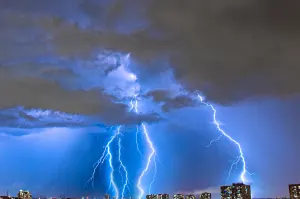
Lightning is more likely in polluted skies, new study finds
Here's the science behind how pollution can enhance lightning.
Air pollution could be causing more severe lightning storms, according to a new study.
Scientists from James Madison University argue that pollution can actually strengthen thunderstorms.
How lightning forms
Lightning forms when negative and positive charges are separated within a cloud by the updraft and downdraft.
The lower negative charges become attracted to the positive charges on the ground, and the higher positive charges become attracted to the negative charges in other clouds. Creating an electrical current, or lightning.
How pollution can enhance lightning
When pollution is pulled into a cloud through the updraft, its particles also get separated, creating the potential for more lightning.
The research team looked at nearly half a million thunderstorms in Washington, D.C. and Kansas City, alongside years of lightning and pollution data.
They found that when air pollution is combined with unstable weather conditions, the frequency of cloud-to-ground lightning strikes increases significantly, and it isn't limited to the United States. Similar patterns have also been seen in Bangkok.
Professor Mace Bentley, a geography professor at JMU and lead author of the study, says in a statement that the findings suggest that no matter where you go in the world, urban pollution is capable of enhancing thunderstorms and lightning.
RELATED: Why is lightning so dangerous?
Header image: Submitted to The Weather Network by Lacey Davey)










